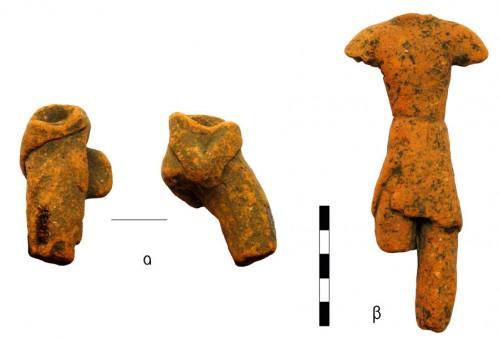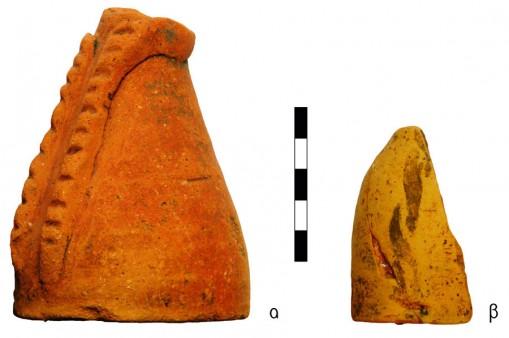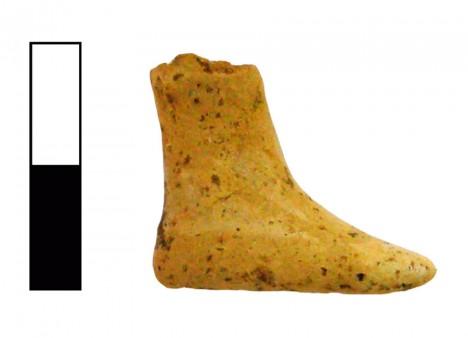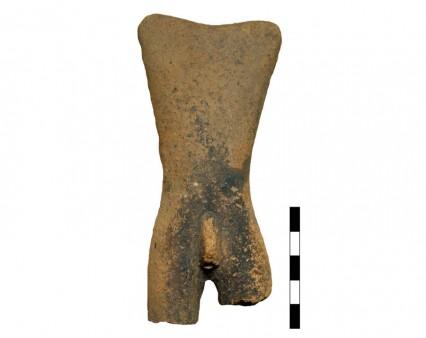PART.3
Dating of handmade clay figurines on the basis of clothing styles is rarely accurate, not only because Minoan dress, both male and female, presents morphological characteristics that remain unchanged throughout the Middle and Late Bronze Age, but also because any variations in details of dress evolution are hard to recognise in the moulded features of such tiny figures. The male garment covering the upper body (fig. 10b – rear view), also seen on figurines from other sites (Malevisi), is probably also Protopalatial in date.

Fig. 11. Fragments of human figurines wearing different kind of Minoan loincloth. Vrysinas’s Peak Sanctuary (C. Davaras, exc. 1972-73); α) lower torso with one-piece cloth forming a codpiece and cross confinement over the buttocks, RMN 16737; β) torso and legs of a figurine, with a kilt in the form of short skirt, RMN 22356.
The Minoan garment covering the lower body is found in a wealth of moulded examples from Vrysinas, which permit a basic re-evaluation of its form and the way it was worn. The codpiece, consisting of a single long piece of cloth wrapped around both hips, forming an acute angle at the back (fig. 11a), and the rectangular loincloth wrapped around the waist and falling like a short skirt, are depicted on many figurines in a wide range of variations (fig. 11b).

Fig. 12 Skirts. Vrysinas’s Peak Sanctuary (C. Davaras, exc. 1972-73); α) bell – shaped skirt with untied belt, RMN 21536; β) fragment of a bell-shaped skirt with imprints of a knitted belt, SN 2.
The wheelmade skirts of the female figurines are accompanied by the applied moulded band of the belt (fig. 12a), tied round the waist in various ways. Even the way in which the two ends of the belt fall down the front of the skirt presents innumerable variations, such as the rendition of the twisted material by deep wavy grooves (fig. 12b). The rich narrative of the female belt is not only ornamental but may also be a feature of the identity of each female figure. As we know, the belt on the female body contains a plethora of symbolisms with regard to her social inclusion and general status.
Finally, in a few cases, plastically-rendered male footwear can be discerned. Some samples even retain faint traces of colour indicating the straps (black on white) of Minoan sandals (fig. 13); rare three-dimensional renditions of these only survive on fragments of ivory figurines.

Fig. 13. Foot of a human figurine with painted black sandal on white skin. Vrysinas’s Peak Sanctuary (C. Davaras, exc. 1972-73), SN 1041.
The rhetoric of the body: focuses and suppressions
A small but equally significant number of figurines represent individual parts of the human body. In this case, too, the largest peak sanctuary of West Crete presents novel sections of the human body compared to the corresponding examples from other peak sanctuaries of Central and East Crete (fig. 14).

Fig. 14. Figurine of a human body part (“Minoan votive limp”). Vrysinas’s Peak Sanctuary (C. Davaras, exc. 1972-73), RMN 17710.
In these strange figurines, the techniques used to focus on and highlight specific body parts are achieved by splitting up the human form. The many different interpretations of these figurines turn on the meaning of the maker’s focus on these particular members. In any case, however, these representations, taken as a whole, indicate the familiarity of the bearers of Minoan culture with the fragmentary human body.
But the narrativity of the anthropomorphic pottery of Vrysinas does not end here. The support of a human figurine, its incorporation into the context of the other pictorial themes, and even its wider setting among the multitude of disparate objects comprising the rich assemblages that characterise the site we call a “peak sanctuary”, are expressions of a narrative whose fragments we are called upon to piece together. Next to the thousands of representations of figures in seal-carving, which preserve the contexts of human behaviour, and the impressive, sometimes life-sized depictions of the wall-paintings, which highlight a wealth of detail, fragmentary ceramic figurines, as an intermediate link in the representation of Minoan man, have not yet said their final word…
BIBLIOGRAPHY
-
D’Agata A.L., 1999. Haghia Triada II: Statuine Minoiche e Post-Minoiche dai Vecchi Scavi di Haghia Triada (Creta), Padova.
-
Λεμπέση Α., 2002. Το ιερό του Ερμή και της Αφροδίτης στη Σύμη Βιάννου. ΙΙΙ: Τα χάλκινα ανθρωπόμορφα ειδώλια, Αθήνα.
-
Πιλάλη-Παπαστερίου Α., 1992. Μινωικά πήλινα ανθρωπόμορφα ειδώλια της Συλλογής Μεταξά, Θεσσαλονίκη.
-
Ρεθεμιωτάκης Γ., 1998. Ανθρωπομορφική πηλοπλαστική στην Κρήτη από τη νεοανακτορική έως και την υπομινωική περίοδο, Αθήνα.
-
Rutkowski B., 1991. Petsofas. A Cretan Peak Sanctuary, Warsaw.